Naval Component/Marinecomponent
 c60 ships 1947-1990. 1300 personal, 7 ships 2025.
c60 ships 1947-1990. 1300 personal, 7 ships 2025.
The Belgian Navy always had been a modest naval force, but it reached in the cold war it’s greatest extent, thanks to the 30-year boom period (“30 glorieuses” in Walloon, “30-jarige bloeiperiode” in Flemish). It’s deep integration of NATO, which the country hosted SHAPE in Casteaux, Mons, and administrative siege in Brussels (formerly in London 1949–1952, then Paris 1952-67), meant Belgium had the responsibility area of a corner of the channel and north sea and the task of mine warfare. In this rewrite and expansion of this 2021 page, we will also see the modern Belgian fleet (1990-2025) and plans for the future, as well as its organization, assets and bases.
The Belgian Navy, NATO’s north sea mine warfare specialist
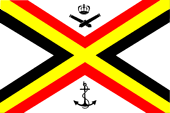 The little Belgian Navy could only oppose to the might of the Kriegsmarine a modest fishery protection vessel in 1940, the Artevelde. See the detail for the ww2 fleet. After 1947 and the start of the Cold War, the Belgian navy was naturally integrated into NATO. But her fleet was in poor conditions.
The little Belgian Navy could only oppose to the might of the Kriegsmarine a modest fishery protection vessel in 1940, the Artevelde. See the detail for the ww2 fleet. After 1947 and the start of the Cold War, the Belgian navy was naturally integrated into NATO. But her fleet was in poor conditions.
First, there was the old Artevelde, formerly in German hands and worn out.
She was recovered in 1945 with 2 twin 105mm guns, a twin 40mm AA, 30 DCs, 64 mines. Her British Parsons turbine units and Babcock & Wilcox boilers had raised steam parameters (32atm, 400°C), but she had no protection and poor stability. She had her machinery sabotaged by the Germans when returned to Belgium as K4 (Former Lorelei), and if classed as frigate, was never repaired, then used as stationary training ship, converted to barrack ship in 1951 and broken up 22.11.1954.
There was also the 30 years old Jan Breydel, completely transformed by the Germans as the floating battery “Barbara”, and no longer seagoing.
The USA delivered Belgium under the general procurement plan the following:
A Tacoma class frigate, Lieutenant ter Zee Victor Billet, which entered service in 1947 (see later).
The Royal Navy delivered 6 surplus Algerine class minesweepers which helped the Belgian navy in its reconstitution process, with the main objective of securing the approaches to the Flemish coasts, still infested by German mines.
The Belgian navy’s limited postwar budget certainly not allowed a larger fleet. It was purely utilitarian for its immediate needs, and rather closely, almost organically integrated into NATO’s maritime defence system, with responsibility for the safety of trade lines between the North Sea, the Channel, and what was still called the “Western approaches”.
Through MDAP, the military side of the Marshall Plan, Belgium received no less 47 minesweepers in the 1950s-1960s, and some modernization to the single escort ship Victor Billet. From then on, the Belgian Navy definitely was assimilated to a specialized anti-mine force. The additional Algerine class vessels (8 in total from 1949 to 1959) were then used as patrol ships and ASW escorts to help Victor Billet. Between 1956 and 1966, 7 oceanic minesweepers of the Agile class were procured, locally called the Artevelde class plus 26 wooden coastal minesweepers of the Adjutant class (locally called Lier class) in 1953-55, of which eight were built locally, and finally twenty Improved “Ham” (local Herstal class) light wooden-built 1956-58 minesweepers. In addition, the imposing minesweepers fleet demanded support vessels, for which two were specially built, Godetia in 1965 and Zinnia in 1967.
The late cold war era
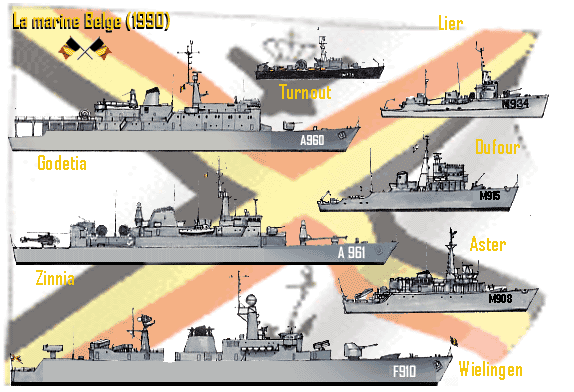
Poster of the Belgian Navy in 1990, showing the ship’s types
1970-80s reforms
The lack of proper defence for this minesweeper fleet, until then provided by the French Marine Nationale and Royal Navy led to study a frigate design in Belgium, able to better protect these minesweepers. This is how the four Wielingen class, the most ambitious ships ever commissioned by the Belgian Navy, were studied and launched. Belgian yards did not possess the capacity, skilled labour or technical means to build them, so they were delegated to Cockerill (Hoboken) and Boëlwelf yards (Temse) in the Netherlands, but on Belgian plans and under their supervision.
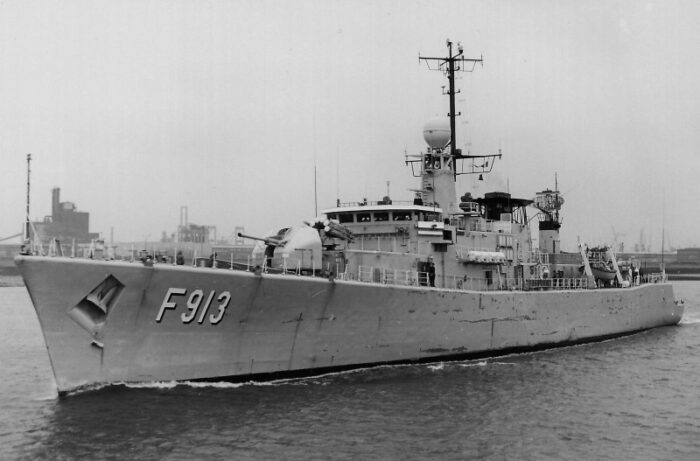
They were launched in 1975-76 and until 1990 gave precisely this advanced escort and projection capability the Belgians requested, and most recognisable vessels of the Belgian fleet to this day. The replacement of the considerable minesweepers fleet started in 1983 with a joint Franco-italo-Belgian project: The “Tripartite” mine hunter program, also fitting the new NATO standards requirements. Ten were built at Béliard shipyards in Ostend in 1984-1990, designated as the Aster class.
1990s Budget cuts
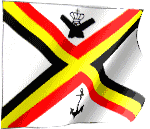 After 1990, the Belgian navy like many others, was in the process of drastic reductions. Only two frigates were maintained in service, another was sold to Bulgaria and eventually one scrapped and two inactivated in 2004. They had been replaced by second-hand Karel Doorman class vessels since. The minesweeper force was reduced to 20 small Herstal class inshore minesweeping crafts and 10 “Tripartites” vessels.
After 1990, the Belgian navy like many others, was in the process of drastic reductions. Only two frigates were maintained in service, another was sold to Bulgaria and eventually one scrapped and two inactivated in 2004. They had been replaced by second-hand Karel Doorman class vessels since. The minesweeper force was reduced to 20 small Herstal class inshore minesweeping crafts and 10 “Tripartites” vessels.
Battle order, 1990, at the peak of the Belgian Navy:

NATO Standing Naval Force Atlantic ships underway 1981
-4 Frigates:
Wielingen class. Fairly versatile and and with missiles, replacing the sold Tacoma class frigate, bringing new capabilities for North Sea NATO exercises.
-63 Minesweepers.
Undoubtedly one the largest of its type then aligned in Europe at this date. It included the ultramodern Aster class mine hunters, the old Agile class oceanic vessels of American origin, the Adjutant class coastal personnel, and the small river and coastal Herstals.
-2 Support ships:
Godetia and Zinnia have been contributing their capabilities to keep these fleets operational since the 1960s.
Organization
The official rebirth of the Belgian Navy was on 1 February 1946, as the “Naval Force”, gradually developed and modernized. Its primary mission later as the “Maritime component” was to ensure Belgian presence in its EEZ, protecte coastal waters and fishery areas, contribute to Belgian foreign policy and trade support, military cooperation with the allies, humanitarian missions, fishing control and oceanographic research as well as police and customs operations or even commercial naval officers training. There is no Belgian Coat Guard indeed.
In case of open war with the Soviet Block, it was to concentate efforts in the North Atlantic for Air/sea control, escort support and mine warfare, take part in multinational, US-led battle groups, under NATO command, and provide 650 personnel for multinational operations of escort vessels for six months (rotation) and lead anti-mine warfare groups with mine hunters and logistic, as well as assisting strategic naval transport.
There is no coast guard force but still an interdepartmental coast guard structure, to handle maritime-security aspects in the EEZ, with an operational Maritime Security Centre to share infortmation between the navy, police, and customs.
The Modern Belgian Navy
Admiral John-Paul Robyns by March 2012 declared one of the most important milestone was the Belgian Navy’s cooperation accord with the Dutch Navy signed in 1996 by political accord, and to “pursue deeper cooperation and integration for both navies”, notably sharing intel, hardware and even ships. Both countries deployed thus similar frigates and mine countermeasures vessels with the crew commonly trained and the ships commonly maintained. This also concerned logistical aspects and exchange of personnel. Both also adopted as standard the NH90 helicopter. This bi-national agreement forms the current Belgian Navy with modernized platform and guaranteed operational status up to 2025.
In 2014, Rear Admiral Michel Hofman stated that the agreement were long in coming but both navies looked for opportunities to cooperate since 1948 already. The stringest point of the cooperation is the commonality of training, education, and maintenance setup in 1997 and the bi-national operational command (“Admiral Benelux”) ABNL. Both shared task specialization asn complementary as well, but with a single-nation support approach, sparing budget hurdles in a context in both until 2022 (and after) way below the 2% GDP reshold.
This Belgian-Dutch naval cooperation evolved in the 1960-70 and 1980s to reach the current status from the 1995 initial agreement signed by both countries MoDs. The agreement still respected the sovereign rights of both and freedome to deploy their own assets independently. The common HQ Admiral BENELUX located in Den Helder is tasked of potential common operations in wartime, and in peacetime, managed common assets in educational and logistic areas. This made the two countries almost acting as a binome inside NATO, also fullfilling EU commitments in multinational exercises and operations with greater flexibility due to the shared assets.
Inside this binome, the Belgian “Naval Component” kept its two core capabilities or escort operations and mine countermeasures (MCM). The current Navy thus comprised two ex-Dutch frigates, five trpartite (FR-NL-BE) minehunters plus a command & support ship a the main naval base in Zeebrugge. This ensure one frigate is at sea every six months. The belgians also ensure the framework of an MCM-group with four minehunters and the dedicated command & support ship also at sea every six months, with two minehunters permanently at sea, rotating with the other three in maintenance, but capable of a full deployment of all five at any time notice.
The Modernisation Plan 2000 for 2015 called VISION 2015, that was initiated following the binational agreements in 1997. It mirrors a similar binational agreement with France more recenlty in 2019, with the Scorpion program, adopting the C&C capabilities and vehicles of the program. The operational characteristics of the new 2015 Force structure was announced to be flexible, modular, sustainable and also deployable and effective with fully equipped and manned ships. The replacement of the ageing Wielingen frigates and upgrade of the mine hunters and new transport ship were key to this transformation.
By July 2005, the Belgian Council of Ministers approved a 1.2 billion euro investment, starting with the purchase of the first two Karel Doorman class Frigates (for 260 million euros), replacing the three remaining Wielingen class frigates, one sold to Bulgaria with an option out on the other two. Albeit this was a reduction in size for Frigates, the new ships are larger, far more modern and incomparably more capable, and ideally suited by their type to fit in the new joint Belgian-Netherlands command for better training and interoperability. The final contract was signed on 22 December 2005 for an acquisition in 2007-2008.
The new frigate Leopold I showed its worth by provided escort for the French aircraft carrier Charles de Gaulle in her eastern Mediterranean deployment as part of the battle group, launching strikes against the Islamic State terrorist group.
Air Assets
“The Belgian Navy’s 40th Squadron reached initial operational capability in August 2015 with three new NH90 Nato frigate helicopters (NFH), enhancing the country’s search and rescue capabilities. The new helicopters were expected to replace the existing Sea King helicopters in the search and rescue (SAR) role by 2018. The fourth NH90 was expected to be delivered in 2016.”
 Leopold I class Frigates
Leopold I class Frigates
Leopold I, Louise-Marie
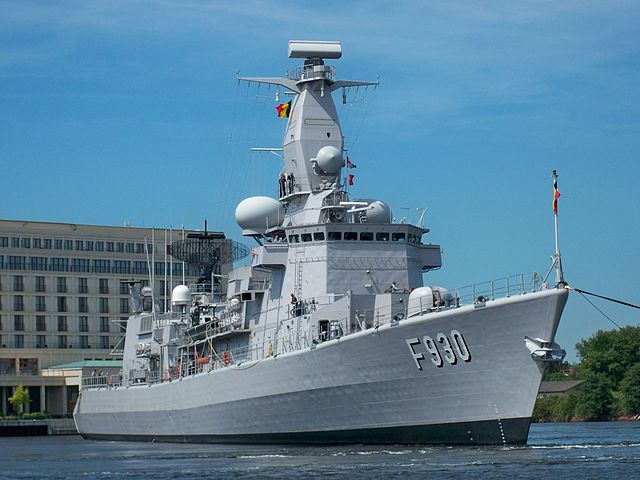
The Belgian Frigate Leopold I (F930). The second one is Louise-Marie (F931), also transferred in 2005 and currently in active service. They were the first two of the Doorman class, dating back 1991.
These were two ex-Karel Doorman class Frigates, completed in 1991 at KM De Schelde, Vlissingen, acquired in 2005 and in service since:
Leopold I was the ex-Karel Doorman, class lead (F930/364), 26.2.1985/20.4.1988/31.5.1991 > 22.12.2005.
Louise-Marie (ex-Willem van der Zaan) (F931/365) 6.11.1985/21.1.1989/28.11.1991 > 22.12.2005.
They were modernized: In 2008, Leopold I and in 2010, Louise-Marie had their Sea Lynx helicopter replaced by a NH90 helicopter, and the helipade was stretched and reinforced, fill lenght now 124.3m. In 2013, Leopold I, and in 2015, Louise-Marie saw the installation of a Seastar radar, APX Vigile ECM suite, SEWACO XI CCS to replace their AR700 ECM suite and SEWACO VIIA CCS.
 CASTOR patrol ships (2014-2015)
CASTOR patrol ships (2014-2015)
Castor, Pollux

Two enlarged version of the patrol craft Jacques Oudart Fourmentin from SOCARENAM, Boulogne-sur-Mer, used by the French Customs. Ordered in December 2012 as replacement for the salvage ship A963 Stern and coastal tug A996 Albatros and A950 Valcke. They had a steel hull but aluminium superstructure and carries each two 37 knots capable inspection Rhibs.
Vega is a third one, ordered 2024, awaited for 2027.
 ASWF class (planned 2030)
ASWF class (planned 2030)
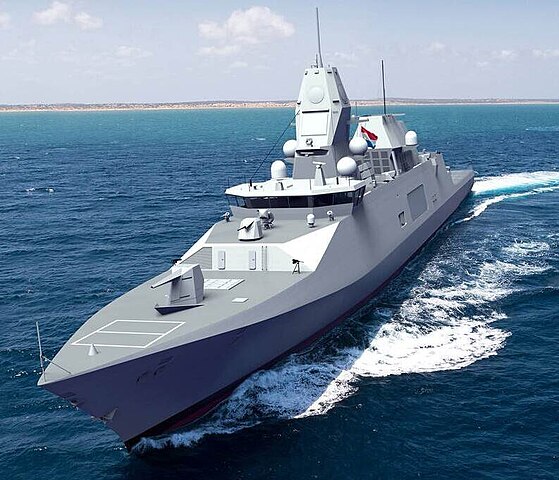
Planned for 2030-31, no name, three 6,400t “Anti-Submarine Warfare Frigate” were ordered to Damen Schelde Naval Shipbuilding. They will replace the Doorman class (Leopold class) as well as Dutch M-class frigates. Planned armament: Mark 54 Lightweight Torpedo 2 × 4-cell NSM launchers, 2 × 8-cell Mk 41 VLS with 64 RIM-162 ESSM Block 2, 1 × RAM RIM-116, 21 each, 1 × 76mm Sovraponte naval gun with DART Munition and 2 × Bofors 40Mk4 plus a NH90 helicopter and UAV.
 Oostende class MCM (2025)
Oostende class MCM (2025)
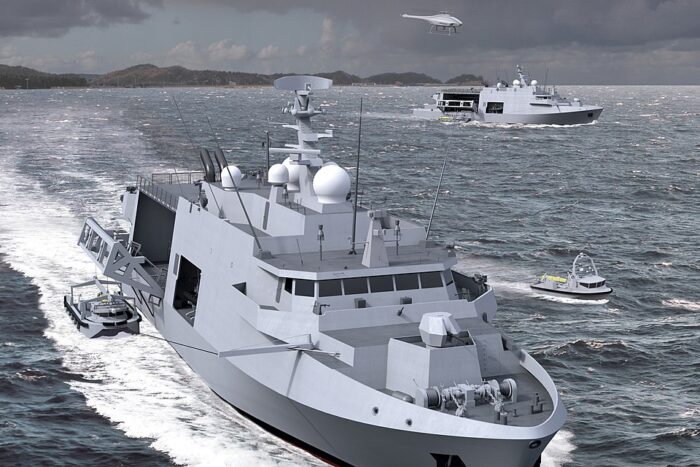
Replacement for the 1980s Tripartie class minehunters, for France, the Netherland and Belgium like the previous class, a new, larger, more capable and stealthy generation of 2800t corvettes ordered in 2020 from Naval Group (master builder), ECA Group Piriou with many Dutch and Belgian Companies as suppliers. Belgium alone ordered six ships, Oostende, Tournai, Brugge, Liège, Antwerpen, Rochefort (M940-M945) to be commissioned for the first in August 2025 (sea trials), two in 2026 and one in 2027, 2028 and 2029. The Netherlands also placed an order for 6 in 2020, and France announced in 2022 also a similar order but modified to carry drones as part of the SLAM-F mine warfare program.
One key aspect is their versatility, armed with a BAE Bofors 40 Mk4, two FN Herstal Sea deFNder/FN M3R LMGs, four FN MAG, 2 water cannon and two Long-range acoustic device (LRAD), two UMS Skeldar V-200 unmanned aerial vehicles, two 7 m SOLAS Viking RHIB, one ECA Inspector 125 UAV mothrships for drones with an Exail FLS-5 sonar, the Exail influence dragger with five integrated CTM magnetic modules, plus an overhead crane and stern crane.
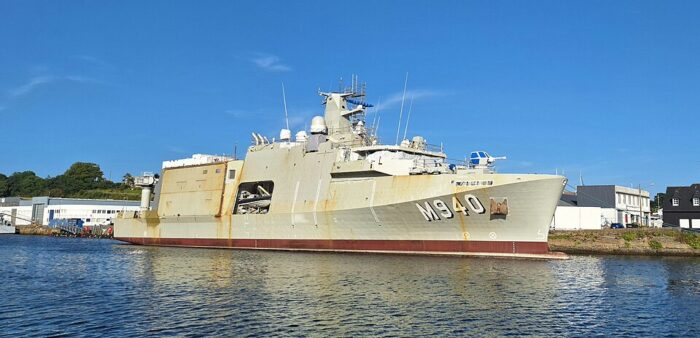
M940 Oostende completed at Concarneau Yard, Britanny.
-Wielingen class frigates
-Frigate Luitenant ter Zee Victor Billet
-Gerlache class minesweepers (Algerine)
-Artevelde class minesweepers (Agile)
-Lier class coastal minesweepers (Adjutant)
-Herstal class coastal/inshore/riverine minesweepers
-Aster class mine hunters
-Support vessel Godetia
-Support vessel Zinnia
Nomenclature of Belgian Vessels
 Lieutenant ter zee Victor Billet
Lieutenant ter zee Victor Billet
Lieutenant ter zee Victor Billet (F910) was the ex- USS Sheboygan, a Tacoma class Frigate laid down initially at Globe, Superior, USA on April 1943, launched on 31 July 1943 and completed on May 1944. She was transferred to Belgium (sold) on 19 mars 1947 notably to replace the old fishery protection vessels Artevelde, now obsolete and armed with German equipments as the former KMS Lorelei. Lieutenant ter zee Victor Billet was named after the funder of the Belgian Navy in 1831. She arrived in stock condition for escort and fishery protection vessel, with two 76mm/50 Mk 21 guns, three twin 40mm/60 Mk 1 Bofors and two single 20mm/70 Mk 4 Oerlikon AA, a 24x 178mm Hedgehog Mk 10 ASWRL, eight depht charge rlkaunchers and two racks for 100 depth charges and baloons. She was modernized with an SA, SL radars, and QGA sonar. Until 1950 she operated as part of the International North Atlantic Weather Organization, and was transferred to fishery protection duties in 1949, then became a training hulk from 1958, disarmed. She was sold for BU the next year.
 Wielingen class Frigates (1975)
Wielingen class Frigates (1975)
Wielingen, Westdiep, Wandelaar and Westhinder
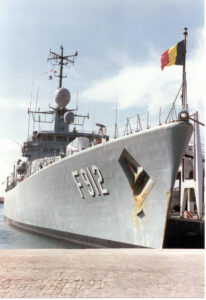 Studies on these ships (E71) began in 1969. The limited capacities of the Belgian shipyards meant that they were for a moment expected to be built in Holland, but they were finally built locally, in Boëwerf and Cockerill, shipyards of Temse and Hoboken. They proceeded from a rather Batavian design, but with French equipment, and props studied for the harsh conditions of the North Sea. Their equipment was fully compatible with the latest NATO standards, in accordance with the full integration of the modest Belgian navy into the NATO defense system.
Studies on these ships (E71) began in 1969. The limited capacities of the Belgian shipyards meant that they were for a moment expected to be built in Holland, but they were finally built locally, in Boëwerf and Cockerill, shipyards of Temse and Hoboken. They proceeded from a rather Batavian design, but with French equipment, and props studied for the harsh conditions of the North Sea. Their equipment was fully compatible with the latest NATO standards, in accordance with the full integration of the modest Belgian navy into the NATO defense system.
The Wielingen, Westdiep, Wandelaar and Westhinder were completed in pairs in January and November 1978. They had a central operation located between two decks, equipped with NBC. They were only gradually modernized. Currently, only the first two are active, the Westhinder having been withdrawn following a fortune at sea and never repaired. The Wandelaar has been placed in reserve. Note: A dedicated article will be done on these ships soon.
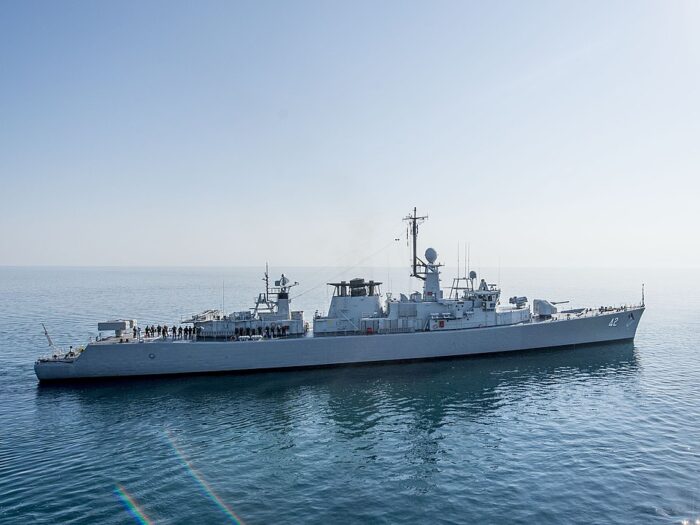

Specifications
Displacement: 1880-2283 tons PC.
Dimensions: 106.4 x 12.3 x 5.3 m.
Propulsion: 2 propellers, 2 CODOG, 1 turb. Olympus, 28,000 hp and 25 knots max., 2 Cockerill V12 diesels giving 6000 hp and 20 knots.
Armament: 4 MM 38 Exocet, 1 MA Sea Sparrow octuple, 1 gun of 100 mm DP, 1 LR ASM Bofors 375 mm, 2 LT L5.
Electronics: DA-05, WM-25, Sonar SQS-505A radars, 2 Corvus decoy launchers.
Crew: 160
 Godetia
Godetia
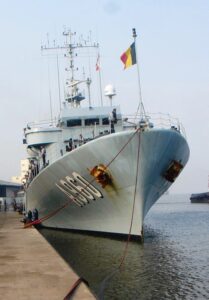 A960 Godetia was a MCM Logistics & Command ship, built at Boelwerf, Temse, laid down on 15 February 1965, launched on 7 December 1965 and Commissioned on 2 June 1966. Decommissioned 2021. She was the first of two support ships acquired to replace World War II-era ships with Zinnia. Used for logistic support to the large fleet of minesweepers in the cold war, Godetia was also used as training ship, royal yacht and for fishery protection. She was deployed many times with NATO’s Standing NATO Mine Countermeasures Group 1 in the Baltic and North seas.
A960 Godetia was a MCM Logistics & Command ship, built at Boelwerf, Temse, laid down on 15 February 1965, launched on 7 December 1965 and Commissioned on 2 June 1966. Decommissioned 2021. She was the first of two support ships acquired to replace World War II-era ships with Zinnia. Used for logistic support to the large fleet of minesweepers in the cold war, Godetia was also used as training ship, royal yacht and for fishery protection. She was deployed many times with NATO’s Standing NATO Mine Countermeasures Group 1 in the Baltic and North seas.

Specifications
Displacement 2,000 t (2,000 long tons) standard, 2,500 t (2,500 long tons) fully loaded
Dimensions: 91.83 x 14 x 3.5m (301 ft 3 in x 45 ft 11 in x 11 ft 6 in)
Power plant: 2 shafts C.Pitch, 4 × ACEC-MAN diesels 4,000 kW (5,400 bhp): 19 knots, RA 6,000 nmi/15 kts
Crew 96, 6×1 12.7 mm (0.50 in) HMG, helipad for Alouette III helicopter
 Zinnia
Zinnia
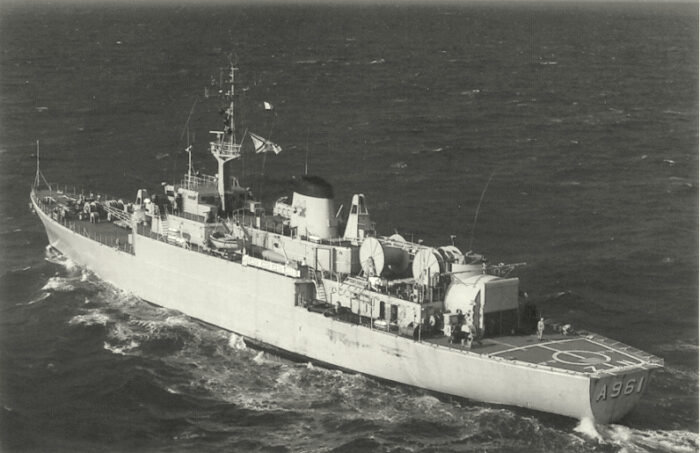
A961 Zinnia was the second Belgian support ship for minesweepers. Officially she worked as a mine countermeasures support ship. She was laid down at Cockerill, Hoboken on 8 November 1966, launched 6 May 1967 and commissioned on 5.9.1967. She also acted as Command and logistic support ship and was a development of Godetia. Modifications included having a bridge relocated further aft, so to install a second supply hold and crane, accommodated in the bow section. She also had a telescoping hangar and landing platform at the stern, accomodating an Alouette II and later Alouette III helicopter. She had two cable reels fitted on the after deckhouse at completion and could carried 500t of cargo and fuel for the minesweepers, acting a smothship when deployed overseas. She was decommissioned in 1993, stricken in January and then scrapped after 2007.

Specifications
Displacement standard 1705t, 2,685t fully loaded.
Dimensions: 94.2 wl(99.5 oa) for 14m wide, and 3.6m in dimensions
Machinery: 2 Cockerill-Ougree V12 TR240CO diesels: 5000 hp, 18 knots
Max speed, kts
diesel oil 120t, range 14,000 nm at 12.5 kts
Armament: 3x 40mm/60 Mk 3, 1 helicopter Alouette II
Radar 2x Decca 1229 Crew 123.
 Turnhout class
Turnhout class

MSI-class inshore minesweepers, similar to the British Ham or Ley classes:
M470 Temse (sold to South Korea 1970)
M471 Hasselt (decommissioned 1989; transferred to Belgian Sea Cadet Corps in 1993)
M472 Kortrijk (decommissioned 1989)
M473 Lokeren (decommissioned 1987)
M474 Turnhout (decommissioned 1991)
M475 Tongeren (decommissioned 1991)
M476 Merksem (decommissioned 1992)
M477 Oudenaarde (decommissioned 1989; stored on dry land in Antwerp)
M478 Herstal (decommissioned 1991)
M479 Huy (decommissioned 1990)
M480 Seraing (decommissioned 1990)
M481 Tournai (sold to South Korea 1970)
M482 Visé (decommissioned 1991)
M483 Ougrée (decommissioned 1992; she is in civilian ownership on the River Medway in Chatham, Kent, England (2007))
M484 Dinant (decommissioned 1992)
M485 Andenne (decommissioned 1991)
 Lier (MSC/Adjutant) class
Lier (MSC/Adjutant) class

MSC-class coastal minesweeper, including 26 Adjutant-class minesweepers via US MDAP:
M910 Diest (sold to Taiwan 1969)
M911 Eeklo (sold to Taiwan 1969)
M912 Lier (sold to Taiwan 1969)
M913 Maaseik (sold to Taiwan 1969)
M914 Roeselare (sold to Norway 1966)
M915 Arlon (sold to Norway 1966)
M916 Bastogne (sold to Norway 1966)
M917 Charleroi (sold to Taiwan 1969)
M918 Sint-Niklaas (sold to Taiwan 1969)
M919 Sint-Truiden (sold to Greece 1969)
M920 Diksmuide (sold to Taiwan 1969)
M921 Herve (sold to Greece 1969)
M922 Malmedy (sold to Greece 1969)
M923 Blankenberge (sold to Greece 1969)
M924 Laroche (sold to Greece 1969)
M925 De Panne (retired from service 1969)
M926 Mechelen (converted to research ship – decommissioned)
M927 Spa (converted to munition transport and renumbered A963 – decommissioned and sold to a Dutch foundation, re-commissioned as museum ship AMS60 Bernisse)
M928 Stavelot (decommissioned 1987)
M929 Heist (decommissioned 1992)
M930 Rochefort (decommissioned 1992)
M931 Knokke (decommissioned 1976)
M932 Nieuwpoort (decommissioned 1991)
M933 Koksijde (decommissioned 1991)
M934 Verviers (ex USN MSC259 – converted to minehunter 1972 – decommissioned 1988)
M935 Veurne (ex USN MSC260 – converted to minehunter 1972 – decommissioned 1987)
 Dufour (Algerine) class
Dufour (Algerine) class

M900 Adrien de Gerlache (ex HMS Liberty, acquired 1949 – decommissioned 1969)
M901 Georges Lecointe (i) (ex HMS Cadmus, acquired 1950 – decommissioned 1959)
M901 Georges Lecointe (ii) (ex HMCS Wallaceburg, acquired 1959 – decommissioned 1969)
M902 Van Haverbeke (i) (ex HMS Ready – acquired 1951 – decommissioned 1960)
M903 Dufour (i) (ex HMS Fancy – acquired 1951 – decommissioned 1959)
F903 Dufour (ii) (ex HMCS Winnipeg – acquired 1959 – decommissioned 1966)
M904 De Brouwer (i) (ex HMS Spanker – acquired 1953 – decommissioned 1966)
M905 De Moor (ex HMS Rosario – acquired 1953 – decommissioned 1966)
 Tripartite class (1986)
Tripartite class (1986)
Class (2025): M915 Aster, M918 Dianthus, M919 Fuchsia, M920 Iris, M922 Myosotis.
Decommisioned ships:
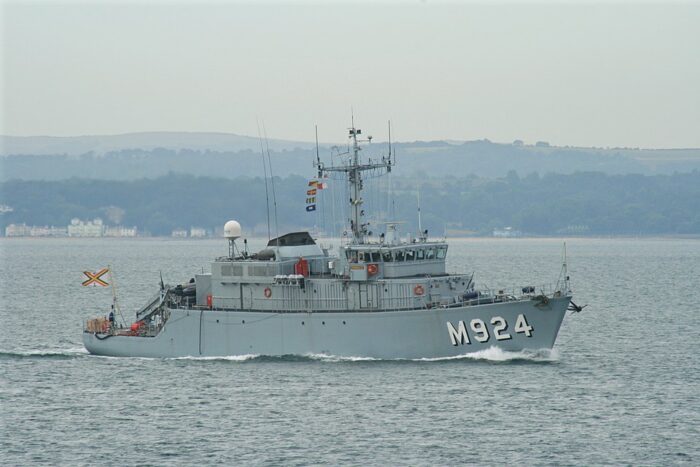
The tripartite class concerned three navies as a common minehunter program in 1980 (NL, BE, FR), for scale economics, and based on common needs on a relatively easy ship to find agreements on.
Originally ten ships were ordered for the Belgian Navy, 5 more in option, never activated. The “Polyship consortium” directed the building programme until dissolved, leading to delays and ships being reordered from Béliard Shipyard, Ostend for the hulls, completiion at Rupelmonde. Differences includes a smaller displacement (519/574 tonnes standard/FL) and the Atlas Elektronik IMCMS combat data system. They have 6 divers and a portable decompression chamber installed abaft the forecastle break. They were known as the “Flower” or Aster class. In 2001 their engines were upgraded, followed by a general overhaul on 2004–2008 with new anti-mine warfare equipment, and same sonar package as the French versions. Crew 33-46 depending on mission.

In 1993, Iris, Fuschia and Dianthus were paid off, sold in 1997 to France. Crocus became an ammunition transfer vessel. Myosotis became an ammunition transport and was was sold to Bulgaria in 2009. This made for 5 ships active today, pending replacement by the “city class”.
 Misc. ships
Misc. ships
Motorminesweeper 105 class: M940-47, decommissioned 1954.
-Barcock (Bar-class boom defence vessel): ex-Royal Navy HMS Barcock; acquired 1946; returned 1949.
-Bootsman Jonson, minesweeper, ex-Kriegsmarine V1001; acquired 1944; decommissioned 1949.
-Bootsman Jonson 2, minesweeper, ex-Kriegsmarine V1300, acquired 1948; decommissioned 1952.
Patrol Boats P900 Jizer class: Ijzer (decom. 1969), P901 Leie (1983) P902 Dender (1954), P902 Liberation (2011), P903 Meuse (1983), P904 Sambre (1983), P905 Schelde (1983), P906 Semois (1983), P907 Rupel (1983), P908 Ourthe (1983).
 Belgian Auxiliaries
Belgian Auxiliaries
A950 Sub-Lieutenant Valcke: tug built 1951, decom. 1980.
A951 Hommel (harbor tug; built in Germany 1953; decommissioned 1999)
A952 Wesp (harbor tug; built in Germany 1953; decommissioned 1984)
A952 Bij (harbour tug; built in The Netherlands 1959; decommissioned 1986)
A955 Eupen (decommissioned 1966)
A956 Krekel (harbour tug; built in Belgium 1961; decommissioned 1986)
A957 Kamina (former German U-boat tender Herman von Wissmann; also wore pennant numbers AP907 and AP957; decommissioned 1967)
A959 Mier (harbour tug; decommissioned 1984)
A960 Godetia (MCM Logistics & Command ship, decommissioned 2021)
A961 Zinnia (supply ship; decommissioned 1993; scrapped 2007)
A962 Mechelen (ex-M926 Mechelen; converted to research ship 1963; decommissioned 1983)
A962 Belgica (decommissioned 2021, gifted to Ukraine)
A963 Spa (ex-M927 Spa; converted to munitions transport ship 1978; decommissioned and sold 1993)
A963 Stern, (ex-Swedish coastguard ship, laid down 1979, in Belgian service 2000, decommissioned 2014) Ready Duty Ship
A964 Heist (ex-M929 Heist; converted to auxiliary ship 1978; reconverted to M929 Heist 1985)
A983 Quatuor (royal yacht; sold 2013)
A996 Albatros (ready duty ship; decommissioned 2014)
A999 Barbara, hovercraft (decommissioned 2009)
Avila (royal yacht; on display at Royal Museum of the Armed Forces and Military History, Brussels)
Inga 1 (tug; built 1959; abandoned in Belgian Congo 1960)
MTL551 (motor transport launch; ex-US Navy MTL551; acquired 1947; sold 1953)
Inland waterways barges
A998 Ekster (munitions transport barge; acquired 1953; decommissioned 1979)
FN1 (abandoned in Belgian Congo 1960)
FN2 (abandoned in Belgian Congo 1960)
FN3 (abandoned in Belgian Congo 1960)
FN4 (decommissioned 1982)
FN5 (decommissioned 1982)
FN6 (decommissioned 1982)
Src/Links
Leconte, Louis (1945). La marine de guerre belge (1830–1940). Brussels: Renaissance du Livre.
Van Raemdonck, Jasper (2000). Het Belgisch Marinekorps, 1939-1940. Erpe: De Krijger.
Koninckx, Christian (2020). De Belgische Marine sedert 1946 : Een geschiedenis. Tielt: Lannoo.
https://www.mil.be/nl/over-defensie/marinecomponent/
https://zm-fn.blogspot.com/
Deloge, Pascal; Sterkendries, Jean-Michel (1997) “Une histoire de braves marins et de petits navires. La Marine belge en Europe”. Revue historique des Armées.
https://web.archive.org/web/20160401171214/http://www.mil.be/fr/la-defense-mod-chod
https://web.archive.org/web/20160320190716/http://www.mil.be/nl/defensie-mod-chod
https://web.archive.org/web/20171205072514/https://www.globalsecurity.org/military/world/europe/be-navycomp.htm
https://www.globalsecurity.org/military/world/europe/be-navycomp.htm
https://web.archive.org/web/20050206205006/http://www.mil.be/navycomp/index.asp?LAN=nl
https://www.navypedia.org/ships/belgium/be_index.htm
https://www.armyrecognition.com/news/navy-news/2023/dsei-2023-belgium-navy-displays-patrol-vessel-bns-castor
https://www.navalanalyses.com/2014/11/karel-doorman-m-class-frigates-of.html
https://en.wikipedia.org/wiki/Belgian_Navy
https://web.archive.org/web/20160320190716/http://www.mil.be/nl/defensie-mod-chod
https://web.archive.org/web/20171201031531/http://www.mc.nato.int/contact/national-support-elements.aspx
https://en.wikipedia.org/wiki/Wielingen-class_frigate
https://www.battleships-cruisers.co.uk/belgian_navy.htm

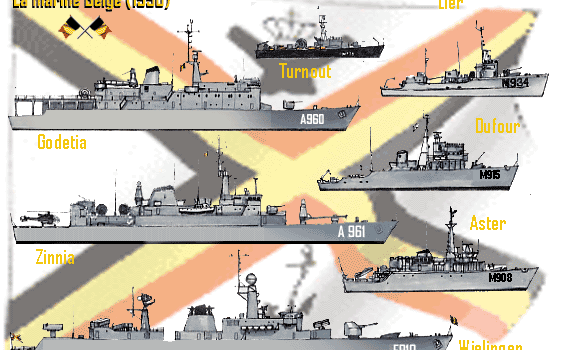
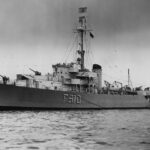


 Latest Facebook Entry -
Latest Facebook Entry -  X(Tweeter) Naval Encyclopedia's deck archive
X(Tweeter) Naval Encyclopedia's deck archive Instagram (@navalencyc)
Instagram (@navalencyc)





 French Navy
French Navy Royal Navy
Royal Navy Russian Navy
Russian Navy Armada Espanola
Armada Espanola Austrian Navy
Austrian Navy K.u.K. Kriegsmarine
K.u.K. Kriegsmarine Dansk Marine
Dansk Marine Nautiko Hellenon
Nautiko Hellenon Koninklije Marine 1870
Koninklije Marine 1870 Marinha do Brasil
Marinha do Brasil Osmanlı Donanması
Osmanlı Donanması Marina Do Peru
Marina Do Peru Marinha do Portugal
Marinha do Portugal Regia Marina 1870
Regia Marina 1870 Nihhon Kaigun 1870
Nihhon Kaigun 1870 Preußische Marine 1870
Preußische Marine 1870 Russkiy Flot 1870
Russkiy Flot 1870 Svenska marinen
Svenska marinen Søværnet
Søværnet Union Navy
Union Navy Confederate Navy
Confederate Navy Armada de Argentina
Armada de Argentina Imperial Chinese Navy
Imperial Chinese Navy Marinha do Portugal
Marinha do Portugal Mexico
Mexico Kaiserliche Marine
Kaiserliche Marine 1898 US Navy
1898 US Navy Sovietskiy Flot
Sovietskiy Flot Royal Canadian Navy
Royal Canadian Navy Royal Australian Navy
Royal Australian Navy RNZN Fleet
RNZN Fleet Chinese Navy 1937
Chinese Navy 1937 Kriegsmarine
Kriegsmarine Chilean Navy
Chilean Navy Danish Navy
Danish Navy Finnish Navy
Finnish Navy Hellenic Navy
Hellenic Navy Polish Navy
Polish Navy Romanian Navy
Romanian Navy Turkish Navy
Turkish Navy Royal Yugoslav Navy
Royal Yugoslav Navy Royal Thai Navy
Royal Thai Navy Minor Navies
Minor Navies Albania
Albania Austria
Austria Belgium
Belgium Columbia
Columbia Costa Rica
Costa Rica Cuba
Cuba Czechoslovakia
Czechoslovakia Dominican Republic
Dominican Republic Haiti
Haiti Hungary
Hungary Honduras
Honduras Estonia
Estonia Iceland
Iceland Eire
Eire Equador
Equador Iran
Iran Iraq
Iraq Latvia
Latvia Liberia
Liberia Lithuania
Lithuania Mandchukuo
Mandchukuo Morocco
Morocco Nicaragua
Nicaragua Persia
Persia San Salvador
San Salvador Sarawak
Sarawak Uruguay
Uruguay Venezuela
Venezuela Zanzibar
Zanzibar Warsaw Pact Navies
Warsaw Pact Navies Bulgaria
Bulgaria Hungary
Hungary

 Bundesmarine
Bundesmarine Dutch Navy
Dutch Navy Hellenic Navy
Hellenic Navy Marina Militare
Marina Militare Yugoslav Navy
Yugoslav Navy Chinese Navy
Chinese Navy Indian Navy
Indian Navy Indonesian Navy
Indonesian Navy JMSDF
JMSDF North Korean Navy
North Korean Navy Pakistani Navy
Pakistani Navy Philippines Navy
Philippines Navy ROKN
ROKN Rep. of Singapore Navy
Rep. of Singapore Navy Taiwanese Navy
Taiwanese Navy IDF Navy
IDF Navy Saudi Navy
Saudi Navy Royal New Zealand Navy
Royal New Zealand Navy Egyptian Navy
Egyptian Navy South African Navy
South African Navy






























 Ukrainian Navy
Ukrainian Navy dbodesign
dbodesign